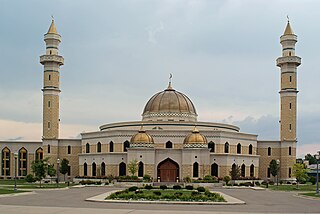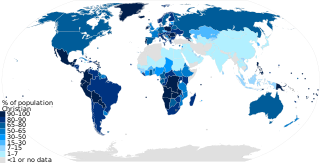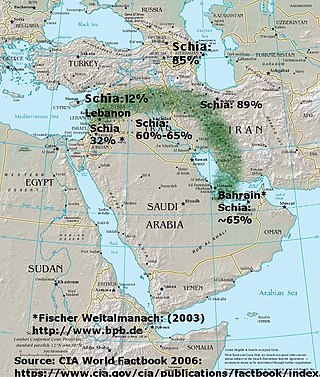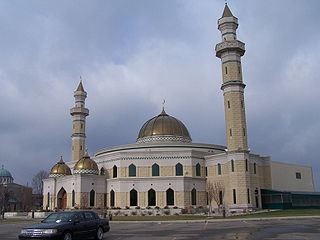
This is a demography of the population of Lebanon including population density, education level, health of the populace, economic status, religious affiliations and other aspects of the population.

Muslims are people who adhere to Islam, a monotheistic religion belonging to the Abrahamic tradition. They consider the Quran, the foundational religious text of Islam, to be the verbatim word of the God of Abraham as it was revealed to Muhammad, the main Islamic prophet. Alongside the Quran, Muslims also believe in previous revelations, such as the Tawrat, the Zabur (Psalms), and the Injeel (Gospel). These earlier revelations are also associated with Judaism and Christianity, which are regarded by Muslims as earlier versions of Islam. The majority of Muslims also follow the teachings and practices attributed to Muhammad (sunnah) as recorded in traditional accounts (hadith).

Islam is the third largest religion in the United States (1%), behind Christianity (63%) and Judaism (2%), and equaling the shares of Buddhism and Hinduism. A 2017 study estimated that 1.1% of the population of the United States are Muslim. In 2017, twenty states, mostly in the South and Midwest, reported Islam to be the largest non-Christian religion. In 2020, the U.S. Religion Census found there to be 4.45 million Muslim Americans, or roughly 1.3% of the population.

As of the year 2021, Christianity had approximately 2.4 billion adherents and is the largest religion by population respectively. According to a PEW estimation in 2020, Christians made up to 2.38 billion of the worldwide population of about 8 billion people. It represents nearly one-third of the world's population and is the largest religion in the world, with the three largest groups of Christians being the Catholic Church, Protestantism, and the Eastern Orthodox Church. The largest Christian denomination is the Catholic Church, with 1.3 billion baptized members. The second largest Christian branch is either Protestantism, or the Eastern Orthodox Church.

Argentina is a predominantly Christian country, with Islam being a minority religion. Due to secular nature of the Argentine constitution, Muslims are free to proselytize and build places of worship in the country.

Islam in Colombia is a minority religion, with most Colombians adhering to Christianity (Catholicism). According to a 2018 study conducted by Pew Research Center, the size of the Colombian Muslim population ranges from about 85,000–100,000 people out of a total population of 50.4 million. However, according to official estimates the Colombian Muslim community numbered just 10,000 people or 0.02% of the total Colombian population. Most Colombian Muslims are immigrants from the Arab World along with a small number of local converts.

According to 2007 statistics released by the United States Department of State concerning Islam in Nicaragua, there are approximately 1,200 to 1,500 Muslims, mostly Sunnis who are resident aliens or naturalized citizens from Palestine, Libya, and Iran or natural-born Nicaraguan citizens born to both of the two groups. The Islamic Cultural Center in Managua serves as the primary salaat (prayer) center for Muslims in the city, with approximately 320 men attending on a regular basis. Muslims from Granada, Masaya, Leon, and Chinandega also travel to the Managua center for Friday prayers. Granada, Masaya, and Leon have smaller prayer centers in the homes of prominent local Muslims. In May 2007 the Sunni leader of the Managua prayer center was dismissed, due to the increase in Iranian influence in the Muslim community and was to be replaced by a Shi'a religious leader. By the end of the reporting period the Shi'a leader had not been identified.

The history of Islam in Iraq goes back almost 1,400 years to the lifetime of Muhammad. Iraq's 98% majority Muslims follow two distinct traditions: Shia Islam (55-60%) and Sunni Islam (35-40%).

Sunni Islam is the dominant religion in Jordan. Muslims make up about 97.2% of the country's population. A few of them are Shiites. Many Shia in Jordan are refugees from Syria, Lebanon, and Iraq.

The Shia Crescent is the notionally crescent-shaped region of the Middle East where the majority population is Shia or where there is a strong Shia minority in the population.
Islam is historically divided into two major sects, Sunni and Shia Islam, each with its own sub-sects. Large numbers of Shia Arab Muslims live in some Arab countries including Lebanon, Yemen, Bahrain, Iraq, Saudi Arabia, Kuwait, Oman, the UAE, and Qatar.
After the death of Muhammad in 632, a group of Muslims, who would come to be known as the Sunnis, believed that Muhammad's successor as caliph of the Islamic community should be Abu Bakr, whereas a second group of Muslims, who would come to be known as the Shias, believed that his successor should have been Ali ibn Abi Talib. This dispute spread across various parts of the Muslim world, which eventually led to the Battle of Jamal and Battle of Siffin. Sectarianism based on this historic dispute intensified greatly after the Battle of Karbala, in which Husayn ibn Ali and some of his close partisans, including members and children of Muhammad's household, were killed by the ruling Umayyad Caliph Yazid I, and the outcry for revenge divided the early Islamic community, albeit disproportionately, into two groups, the Sunni and the Shia. This is known today as the Islamic schism.
The Constitution of the United Arab Emirates provides for freedom of religion by established customs, and the government generally respects this right in practice; however, there are some restrictions. The federal Constitution declares that Islam is the official religion of the country. The Government confirmed it illegal to convert from Islam and leaving the Islamic faith is considered apostasy, a crime punishable by death.
Although the majority of the Nigerian Muslim population is Sunni, there is a small Shia minority, particularly in the northern states of Kano and Sokoto. However, there are no actual statistics that reflect a Shia population in Nigeria, and a figure of even 5% of the total Nigerian Muslim population is thought to be too high “because of the routine conflation of Shi’a with Sunnis who express solidarity with the Iranian revolutionary program, such as those of Zakzaky’s Ikhwani.”
Shia Islam in Africa is the continent's second most widely professed sect of Islam behind Sunni Islam.
Latin American Muslims are Muslims from countries in Latin America. A survey conducted by the Pew Research Center in 2010 found that Muslims make up 0.1% of all of Latin America's population.
Religion in Latin America is characterized by the historical predominance of Catholicism, and growing number and influence of a large number of groups that belong to Protestantism, as well as by the presence of Irreligion. According to survey data from Statista in 2020, 57% of the Latin American population is Catholic and 19% is Protestant.

Islam in Lebanon has a long and continuous history. According to an estimate by the CIA, it is followed by 63% of the country's total population. Sunnis make up 31.9%, Twelver Shia make up 31.2%, next to smaller percentages of other Shia branches, such as Alawites and Ismailis. The Druze community is designated as one of the five Lebanese Muslim communities, even though most Druze do not identify as Muslims, and they do not accept the five pillars of Islam.

Adherents of Islam constitute the world's second largest religious group. A projection by the PEW suggests that Muslims numbered approximately 1.9 billion followers in 2020. Studies in the 21st century suggest that, in terms of percentage and worldwide spread, Islam is the fastest-growing major religion in the world, mostly because Muslims have more children than other major religious groups. Most Muslims are either of two denominations: Sunni or Shia. Islam is the majority religion in several subregions: Central Asia, Western Asia, North Africa, West Africa, the Sahel, and the Middle East. The diverse Asia-Pacific region contains the highest number of Muslims in the world, surpassing the combined Middle East and North Africa.

A 2009 survey by the Pew Research Center estimated that 10-13% of Muslims worldwide adhere to Shia Islam, with a global total of between 154 million and 200 million Shia Muslims. In the Americas, Pew estimated a population of just under 4.6 million Muslims overall in 2009, with a small portion of those being Shia.












